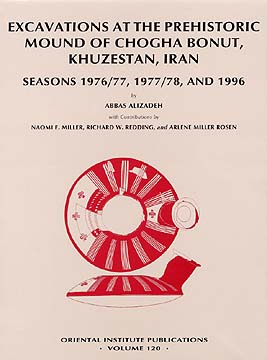OIP 120. Excavations at the Prehistoric Mound of Chogha Bonut, Khuzestan, Iran, Seasons 1976/77, 1977/78, and 1996 Abbas Alizadeh, with contributions by N. F. Miller, A. M. Rosen, and R. W. Redding

Purchase Download Terms of Use
Lowland Susiana, in the modern-day province of Khuzestan, southwestern Iran, was a major contributor to the cultural development of the ancient Near East. Thanks to more than a century of archaeological investigation in Iran, Susiana is also comparatively the best-known region.
Excavations at numerous sites in Susiana, but primarily at Susa and Chogha Mish, provided a long sequence of archaeological phases that span some 8,000 years, from early prehistoric times to the early Islamic period. The initial phases of the colonization of Susiana by early farmers, however, remained unknown until a series of excavations at Chogha Bonut pushed the earliest period of occupation of Susiana to the aceramic phase, ca. 7200 b.c.
The present publication presents and analyzes the results of three seasons of excavations at Chogha Bonut. The results of the excavations therefore add to the already rich picture of cultural development in the region, the initial chapter of human adaptation in the early phases of village life in the Near East.
- Oriental Institute Publications 120
- Chicago: The Oriental Institute, 2003
- ISBN 1-885923-23-6
- Pp. xxxii + 161; 47 figures, 26 plates, 16 tables
- Clothbound 9 x 11.75 in / 23 x 30 cm
- $95.00

